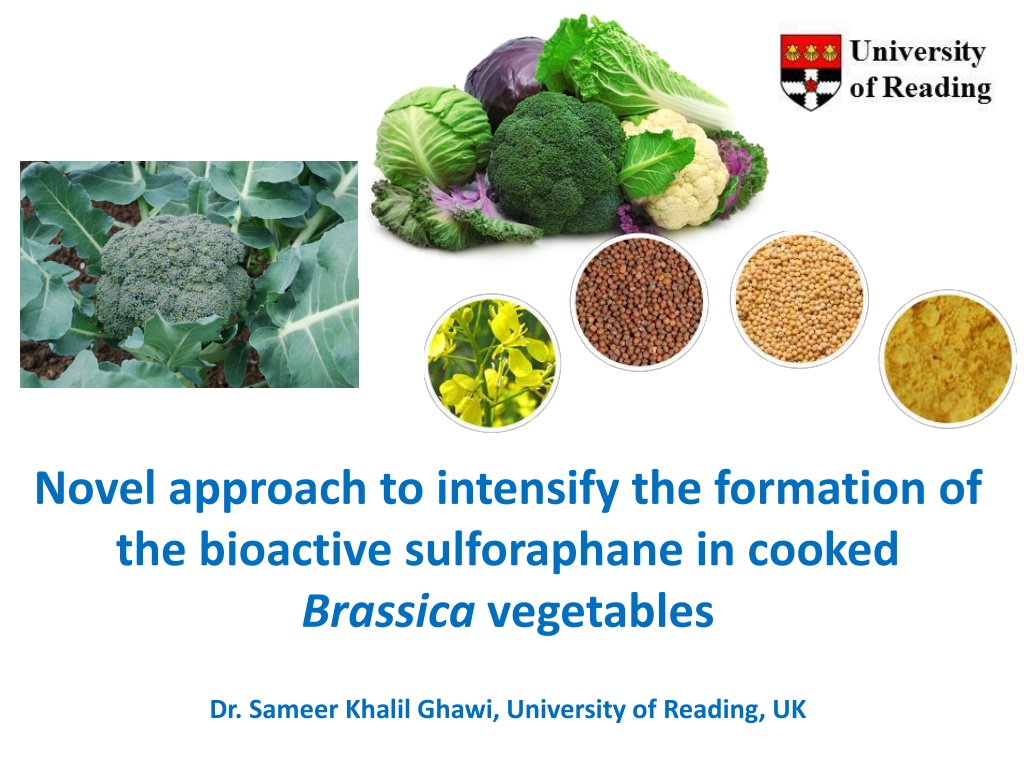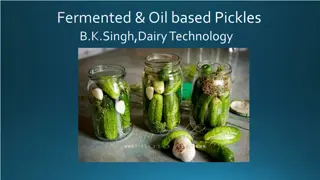Enhancing Bioactive Sulforaphane Formation in Cooked Brassica Vegetables
Brassica vegetables contain glucosinolates, which are secondary plant metabolites with potential health benefits. Dr. Sameer Khalil Ghawi's research explores a novel approach to intensify the formation of the bioactive sulforaphane in cooked Brassica vegetables by optimizing the glucosinolate-myrosinase system. The breakdown products of glucosinolates, particularly sulforaphane, have shown chemoprotective and antimicrobial properties. Understanding the thermal stability of glucosinolates and myrosinase is crucial for maximizing the health benefits of these vegetables.
Download Presentation

Please find below an Image/Link to download the presentation.
The content on the website is provided AS IS for your information and personal use only. It may not be sold, licensed, or shared on other websites without obtaining consent from the author. Download presentation by click this link. If you encounter any issues during the download, it is possible that the publisher has removed the file from their server.
E N D
Presentation Transcript
Novel approach to intensify the formation of the bioactive sulforaphane in cooked Brassica vegetables Dr. Sameer Khalil Ghawi, University of Reading, UK
Glucosinolates-myrosinase system in Brassica vegetables Glucosinolates (GLS),sulphur and nitrogen-rich products, are a group of secondary plant metabolites found in Brassica vegetables. To date, over 120 different glucosinolates have been identified (Oerlemans et al., 2005), categraizing is based on the side group (Fahey, Zalcmann, & Talalay, 2001) Myrosinase (thioglucoside glucohydrolase) : is a family of enzymes found in all glucosinolate containing plants 17/09/2024 Dr. Sameer Ghawi
Glucosinolates-myrosinase system in Brassica vegetables In plant tissues, myrosinase and glucosinolates are physically segregated in distinct compartments. This cellular segregation keeps glucosinolates stable. Myrosinase catalyzes the hydrolysis of glucosinolates. Upon tissues damage during handling or processing of Brassica vegetables, myrosinase comes into contact with glucosinolates and the hydrolysis initiates. Hydrolysis releases glucose and different compounds depending on the side group of glucosinolates and the reaction conditions (pH, EPS, metallic ions). 17/09/2024 Dr. Sameer Ghawi
Importance of the breakdown products In addition to their nutritional value, Brassica vegetables are thought to have chemoprotective properties Some of the hydrolysis compounds (e.g. indole and isothiocyanates) are claimed to be cancer-protective compounds. Sulforaphane (isothiocyanate), derivative of 4-methylsulfinylbutyl glucosinolate (glucoraphanin), received a particular interest. Moreover, recent studies showed sulforaphane to exhibit antimicrobialactivity against a wide variety of bacterial and fungal pathogens. Glucosinolates and the hydrolysis compounds contribute the distinct aromas and tastes in Brassica vegetables. 17/09/2024 Dr. Sameer Ghawi
Glucosinolates-myrosinase system 17/09/2024 Dr. Sameer Ghawi
Glucoraphanin- myrosinase reaction 17/09/2024 Dr. Sameer Ghawi
Thermal stability of glucosinolates- myrosinase system Glucosinolates are thermally stable, and most of the decline in glucosinolates content after cooking is basically due to leaching into processing water. On the other side, myrosinase is more likely to be inactivated after domestic cooking, and hence stop of the hydrolytic breakdown of glucosinolates. This means consuming intact glucosinolates from cooked brassica. Fortunately, glucosinolate hydrolysis may occur in the gastrointestinal tract under the action of the colonic microflora, however, the hydrolysis rate is much lower compared to hydrolysis resulting from the plant myrosinase (usually less than one third). 17/09/2024 Dr. Sameer Ghawi
Study approach During my PhD project, I utilized two approaches to enhance the formation of sulforaphane. The first was by applying HPP which I am not talking about today. The second approach: Addition of low concentrations of Brassica condiments to cooked broccoli, has thermally inactive myrosinase, will reinitiate the hydrolysis reaction of glucoraphanin towards sulforaphane. These sources will provide an intact myrosinase, and might be used as a condiments to improve palatability of Brassica vegetables. Mustard seeds as was used as additive in this study: Has higher thermal stability myrosinase. does not contain ESP as previously reported. Very widely used in diet. 17/09/2024 Dr. Sameer Ghawi
Sample preparation Methods Cut about 4 Cm from top Vacuum sealed (100g, LDPE) Processed at different conditions (30 to 100 C; 4, 8 and 12 min) Freezing in liquid nitrogen lyophilization Grinding and sieving Broccoli powder, -20 C analysis
Methods 17/09/2024 Dr. Sameer Ghawi
Myrosinase thermal stability The important condition, as source A might be added while or at the end of cooking Mustard seeds 1 0.8 0.6 A/A0 % Broccoli 0.4 1 0.9 0.2 0.8 Residual Activity A/A 5 Min 10 Min 0.7 0 0.6 60 70 80 90 100 0.5 T C 0.4 0.3 Domestic cooking we are completely loosing myrosinase activity, and hence stopping the enzymatic reaction 0.2 0.1 4 Min 8 Min 12 Min 0 30 40 50 60 70 80 90 100 T C 17/09/2024 Dr. Sameer Ghawi
Thermal stability of glucoraphanin in broccoli (no enzymatic reaction, no leaching) Glucoraphanin content in raw broccoli:10.3 0.21 mol/g DW 12 4 min; 8 min; 12 min 10 Glucoraphanin content mol/g DW 8 6 4 2 0 80 C 90 C 100 C 17/09/2024 Dr. Sameer Ghawi
Effect of thermal processing on sulforaphane content in broccoli 8 ( ) 4 min; ( ) 8 min; ( ) 12 min 7 Sulforaphane content mol/g DW 6 5 4 3 2 1 0 30 40 50 60 70 80 90 100 T C 17/09/2024 Dr. Sameer Ghawi
Effect of thermal processing on sulforaphane nitrile content in broccoli 10 9 ( ) 4 min; ( ) 8 min; ( ) 12 min 8 Sulforaphane nitrile content mol/g DW 7 6 5 4 3 2 1 0 25 35 45 55 65 75 85 95 T C 17/09/2024 Dr. Sameer Ghawi
Sulforaphane content in cooked broccoli samples after adding mustard seed powder. 7 6 Sulforaphane content mol/g DW 5 4 3 2 1 0 4 Min 8 Min 12 Min boiled broccoli, no mustard seeds; boiled broccoli with unprocessed MS, 1% boiled broccoli with unprocessed MS, 2%; boiled broccoli with processed MS (2%) for 5 min at 90 C; boiled broccoli with processed MS (2%) for 5 min at 100 C 17/09/2024 Dr. Sameer Ghawi
Conclusions In raw broccoli the predominant hydrolysis product of glucoraphanin is sulforaphane nitrile (more than 85%), due to the activity of epithiospecifier protein. However, mild cooking increases the conversion of glucoraphanin to sulforaphane, due to the inactivation of epithiospecifier protein while myrosinase is still partly active Domestic cooking leads to myrosinase activation, while glucoraphanin is still stable. Adding raw or slightly cooked mustard seeds to fully cooked broccoli provides a natural source of myrosinase enzyme needed to convert glucoraphanin to sulforaphane. This guarantees the conversion of all glucoraphanin to anticarcinogen sulforaphane, but not to sulforaphane nitrile which does not have antiarcinogenic properties. 17/09/2024 Dr. Sameer Ghawi
Sensory and consumer study F/M (73.6%/26.4%) Gender 18-30 years (43.3%) 31-45 years (40.3%) Age 45-65 years (19.4%) Less than once a month (9.7%) More than once a month (45.8%) Broccoli consumption More than once a week (44.4%) Steamed (36.1%) Cooking methods used for broccoli (consumers selected all that applied) Boiled (62.5%) Microwaved (26.4%) Stir-fried (55.6%) Grilled (4.2%) Raw (12.5%) 17/09/2024 Dr. Sameer Ghawi
Consumer liking of six broccoli samples prepared by different methods Overall liking Liking of appearance Liking of taste Liking of texture Sample 6.2b 1.8 6.1b 1.8 6.4a 1.8 6.2ab 2.0 1SoVi,0%MS 5.0c 2.2 5.2c 1.9 4.8b 2.4 5.8b 1.9 2SoVi,1%MS7 5.3c 2.0 5.4bc 2.1 5.4b 2.2 5.8b1.8 3SoVi,2%PMS 7.1a 1.2 7.3a 1.2 6.9a 1.4 6.7a 1.5 5NoBo,0%MS 5.1c 2.1 6.0bc 1.8 5.0b 2.2 6.1ab 1.8 6NoBo,1%MS Direct comparison study (overall liking) 6.3 a 1.7 4.8 b 2.3 SoVi,0%MS 4MilCo,0%MS 1: Sous vide cooking (100 C, 12 min, 0%MS); 2: Sous vide cooking (100 C, 12 min, 1%MS) ; 3: Sous vide cooking (100 C, 12 min, 2%processed MS); 4: Mildly cooked, sous vide (70 C, 12 min, 0%MS); 5: Normal boiling (100 C, 7 min, 0%MS); 6: Normal boiling (100 C, 7 min, 1%MS); MS: Mustard seeds; different superscripts in the same column indicate significantly different means (P<0.05). Data are mean SD, n=72. 17/09/2024 Dr. Sameer Ghawi
Liking of five clusters of consumers obtained from hierarchical cluster analysis 2SoVi 1%MS7 3SoVi 2%PMS 4MilCo 0%MS 5NoBo 0%MS 6NoBo 1%MS 1SoVi 0%MS Cluster 6.8a 1.3 3.9b 1.3 3.0b 1.2 6.3a 2.0 7.2a 1.1 3.8b 1.0 1(13.9%) 6.1ab 1.1 7.0a 1.9 5.5b 2.0 3.6c 1.5 6.8ab 1.9 6.7ab 1.4 2(31.9%) 5.1bc 1.7 3.6c 1.6 6.6ab 2.4 6.8ab 1.0 7.0a 1.6 3.4c 0.8 3(19.4%) 6.0b 0.5 6.6ab 0.4 6.8ab 0.7 7.8a 1.7 7.0ab 0.8 7.6ab 0.7 4(6.9%) 7.0a 1.9 3.8bc 2.1 5.1b 0.9 3.1c 1.8 7.6a 1.4 4.5bc 1.2 5(27.7%) 6.2 5.1 5.3 4.8 7.1 5.1 Overall liking 17/09/2024 Dr. Sameer Ghawi
Conclusions Isothiocyanate formation in broccoli could be increased by employing low intensity cooking conditions which leaves myrosinase in its active form, or by the addition of a natural source of myrosinase to fully cooked broccoli. Mild cooking option was not acceptable to consumers. Addition of mustard seed powder as an active source of myrosinase, significantly changed sensory attributes of broccoli samples and affected consumer liking. Despite the significant increase in pungency and burning sensation in samples with added mustard seeds, a considerable number of consumers (32%) liked it More work should be done to assess the effect of adding other Brassica condiments (e.g. rocket, watercress and horseradish) on the sensory attributes and consumer acceptance of cooked Brassica vegetables. In addition, isothiocyanate bioavailability should be assessed after adding those condiments to cooked Brassica vegetables. 17/09/2024 Dr. Sameer Ghawi
Aknowledments Prof. Keshavan Niranjan Dr. Lisa Methven 17/09/2024 Dr. Sameer Ghawi
brocolli-house-photomanipulation Please know how to eat me! Mr Broccoli.. Thank you for your patience, questions
Introduction1 Biplot (axes F1 and F2: 63.23 %) NoBo 0%MS SwTa 25 SoVi 0%MS SwAt CLUS1 CLUS3 CLUS5 BuOd Str HaTe MilCo 0%MS Vib 5 FTex F2 (31.05 %) SoVi 2%PMS GrCo Gre/GraFl -50 -30 -10 10 30 Mos CLUS4 Sog SuOd CLUS2 Gre/Gra SaFl BiAt -15 POd Bu/PuAt PuFl BuSe SaTa BiTa MeAt MuFl Gra/Gri MeTa NoBo 1%MS MuOd SoVi 1%MS -35 F1 (32.18 %) 17/09/2024 Dr. Sameer Ghawi
The change in sulforaphane and sulforaphane quantities during processing Sulforaphane nitrile Sulforaphane Unprocessed broccoli Processed at 70 C, 8 min Processed at 90 C, 8 min Processed at 90 C 12 min
Sensory characterisation 1SoVi 0%MS 2SoVi 1%MS 3SoVi 2%PMS 4MilCo 0%MS 5NoBo 0%MS 6NoBo 1%MS Significance (p value) Green Colour (Florette) 67.6 ab 65.3 ab 74.2 a 68.9 ab 58.7 b 60.4 ab 0.02 Evenness of green colour 52.6 a 55.7 a 62.5 a 61.8 a 55.3 a 55.0 a 0.38 Yellow (florets) 23.2 a 17.8 a 16.3 a 12.1 a 18.4 a 19.1 a 0.54 Vibrancy 43.0 b 42.7 b 48.4 ab 62.3 a 61.5 a 57.7 ab <.01 Firmness of texture 41.8 bc 35.7 c 49.4 b 89.4 a 49.6 b 50.1 b <.0001 Soggy 31.3 a 35.8 a 23.1 a 5.8 b 21.2 ab 20.0 ab <.0001 Boiled green vegetables odour 57.0 a 52.0 a 47.3 a 46.7 a 44.9 a 43.4 a 0.37 Sulfur odour 12.0 a 13.4 a 10.2 a 13.0 a 7.3 a 12.0 a 0.08 Pungent odour 12.1 ab 19.2 ab 15.2 ab 21.2 a 8.2 b 15.1 ab 0.01 Mustard odour 0.3 b 18.1 a 11.0 a 0.0 b 0.0 b 9.7 ab <.0001 Earthy odour 8.0 a 11.4 a 9.5 a 11.3 a 8.7 a 9.9 a 0.88 Green/grassy 34.3 ab 32.8 ab 29.6 ab 40.4 a 25.7 b 29.7 ab 0.07 Sweet odour 12.7 a 9.8 a 12.0 a 16.1 a 13.7 a 11.8 a 0.37 Savoury odour 8.5 a 12.9 a 10.1 a 9.7 a 7.8 a 10.8 a 0.38 Burnt odour 3.0 a 0.6 a 0.8 a 0.3 a 1.6 a 0.7 a 0.18 Bitter taste 14.2 ab 22.6 ab 26.5 a 18.9 ab 10.5 b 23.0 ab 0.03 Sweet taste 18.1 a 8.2 b 9.7 ab 17.2 ab 18.7 a 9.7 ab <.01 Umami taste 10.3 ab 12.9 a 11.2 ab 10.3 ab 7.3 b 10.2 ab 0.07 Sour taste 3.3 a 4.7 a 4.0 a 2.2 a 2.0 a 3.1 a 0.32 Salty taste 3.7 ab 8.1 a 5.1 ab 2.6 b 2.4 b 4.5 ab 0.02 Metallic taste 7.9 ab 11.8 a 12.5 a 7.0 ab 3.7 b 12.5 a <.01 Boiled green vegetables flavour 48.6 a 43.0 a 42.2 a 37.7 a 39.6 a 37.2 a 0.55 Sulfur flavour 10.0 a 14.3 a 13.1 a 6.3 a 6.2 a 9.8 a 0.08 Pungent flavour 9.6 cd 27.9 ab 37.1 a 12.6 bcd 4.8 d 25.1 abc <.0001 Mustard flavour 0.3 b 41.8 a 43.2 a 0.0 b 0.0 b 36.7 a <.0001 Earthy flavour 8.6 a 11.2 a 14.6 a 9.7 a 8.2 a 9.1 a 0.41 Green/grassy flavour 30.6 ab 29.3 ab 27.2 b 40.6 a 26.4 b 25.7 b 0.01 Savoury flavour 11.3 ab 14.8 a 12.9 ab 6.7 b 7.5 b 10.8 ab 0.01 Burnt flavour 1.3 a 1.2 a 1.5 a 0.0 a 0.0 a 0.7 a 0.62 Stalk flavour 11.4 a 13.7 a 8.7 a 18.0 a 11.1 a 14.3 a 0.36 Moist 49.8 a 49.2 a 46.9 a 28.4 b 48.3 a 51.6 a <.0001 Hard texture 32.6 b 25.7 b 35.6 b 80.6 a 37.6 b 34.2 b <.0001 Grainy/gritty 0.4 b 5.3 ab 9.0 a 3.9 ab 1.0 ab 7.2 ab 0.02 Burning sensation 0.0 c 41.6 ab 51.4 a 0.0 c 0.3 c 35.2 b <.0001 Stringy 7.4 b 4.3 b 4.7 b 22.9 a 8.1 b 3.2 b <.01 Burn/pungncy aftertaste 2.6 c 30.3 b 46.5 a 1.9 c 1.5 c 24.7 b <.0001 Bitter aftertaste 7.4 c 18.7 a 17.4 ab 12.3 abc 5.8 c 8.2 bc <.01 Sweet aftertaste 9.6 a 3.8 a 5.1 a 7.5 a 8.4 a 3.2 a 0.03 Savoury aftertaste 8.5 a 13.4 a 10.2 a 7.5 a 6.0 a 7.7 a 0.07 Earthy aftertaste 6.0 a 7.3 a 7.7 a 11.1 a 4.7 a 7.7 a 0.34 17/09/2024 Dr. Sameer Ghawi Metallic aftertaste 4.7c 13.6a 12.3ab 6.1bc 1.2c 10.2abc <.0001























